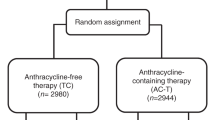Abstract
In order to explore the effect of neoadjuvant chemotherapy (NACT) on clinical mid-course and pathological complete response (pCR) at surgery in different biological breast cancer subtypes. The GeparTrio study included 2,072 patients with operable or locally advanced breast cancer. After two cycles with docetaxel, doxorubicin and cyclophosphamide (TAC) patients were randomized according to their clinical response. Clinical and biological factors were assessed for predicting clinically mid-course response and pCR at surgery. The overall pCR rate, defined as no invasive residuals in breast and axilla, was 20.5%. The highest pCR rate of 57% was observed in patients below 40 years of age with triple negative or grade 3 tumors. Independent factors for mid-course response and pCR were: young age, non-T4 tumors, high grade, and hormone receptor status, the strongest single predictive factor. Within the biological subtypes, grading was an independent factor to predict pCR for luminal tumors, clinical tumor stage for the HER2 like tumors and age for the triple negative ones. Grading gave independent information for mid-course response within the triple negative group. No factor predicted mid-course response within the other groups. Grading and age can identify subgroups within the luminal and triple negative patients who have an increased benefit from NACT.



Similar content being viewed by others
References
Darb-Esfahani S, Loibl S, Müller BM et al (2009) Identification of biology-based breast cancer types with distinct predictive and prognostic features: role of steroid hormone and HER2 receptor expression in patients treated with neoadjuvant anthracycline/taxane-based chemotherapy. Breast Cancer Res 11:R69
von Minckwitz G, Sinn HP, Raab G et al (2008) Clinical response after two cycles compared to HER2, Ki-67, p53, and bcl-2 in independently predicting a pathological complete response after preoperative chemotherapy in patients with operable carcinoma of the breast. Breast Cancer Res 10(2):R30
Rouzier R, Perou CM, Symmans WF et al (2005) Breast cancer molecular subtypes respond differently to preoperative chemotherapy. Clin Cancer Res 11:5678–5685
Colleoni M, Viale G, Zahrieh D et al (2008) Expression of ER, PgR, HER1, HER2 and response: a study of preoperative chemotherapy. Ann Oncol 19:465–472
Colleoni M, Bagnardi V, Rotmensz N et al (2009) Increasing steroid hormone receptors expression defines breast cancer subtypes non responsive to preoperative chemotherapy. Breast Cancer Res Treat 116:359–369
von Minckwitz G, Raab G, Caputo A et al (2005) Doxorubicin with cyclophosphamide followed by docetaxel every 21 days compared with doxorubicin and docetaxel every 14 days as preoperative treatment in operable breast cancer: the Geparduo study of the German Breast Group. J Clin Oncol 23:2676–2685
von Minckwitz G, Kuemmel S, Vogel P et al (2008) Intensified neoadjuvant chemotherapy in early-responding breast cancer: phase III randomized GeparTrio study. J Natl Cancer Inst 100:552–562
von Minckwitz G, Kümmel S, Vogel P et al (2008) Neoadjuvant vinorelbine–capecitabine versus docetaxel–doxorubicin–cyclophosphamide in early nonresponsive breast cancer: a phase III randomized GeparTrio trial. J Natl Cancer Inst 100:542–551
Sinn HP, Schmid H, Junkermann H et al (1994) Histological regression of breast cancer after primary (neoadjuvant) chemotherapy. Geburtsh u Frauenheilk 54:552–558
Loibl S, Müller B, Roller M et al. (2008) Local versus central HER2 immunohistochemistry correlates with kinetic RT-PCR but only central immunohistochemistry and RT-PCR predict pathological complete response: results from the neoadjuvant multicenter Gepar-Trio trial. Cancer Res 69(Suppl) (2): Abstract 1070
Guarneri V, Broglio K, Kau S-W et al (2006) Prognostic value of pathological complete response after primary chemotherapy in relation to hormone receptor status and other factors. J Clin Oncol 24:1037–1044
Sorlie T, Perou CM, Tibshirani R et al (2001) Gene expression patterns of breast carcinomas distinguish tumor subclasses with clinical implications. Proc Natl Acad Sci USA 98:10869–10874
Liedtke C, Hatzis C, Symmans FW et al (2009) Genomic Grade Index is associated with response to chemotherapy in patients with breast cancer. J Clin Oncol 27:3185–3191
von Minckwitz G, Budczies J, Loibl S et al. (2009) Validated 3 gene signature predicts response to neo-adjuvant chemotherapy in luminal breast cancer—results from GeparTrio and GeparQuattro study. Cancer Res 69(Suppl) (24): Abstract 2132
Mazoumi C, Peintinger F, Wan-Kau S et al (2007) Residual carcinoma in situ in patients with complete eradication of invasive breast cancer after neoadjuvant chemotherapy does not adversely affect patient outcome. J Clin Oncol 25:2650–2655
Goldstein NS, Decker D, Severson D et al (2007) Molecular classification system identifies invasive breast carcinoma patients who are most likely and those who are least likely to achieve a complete pathologic response after neoadjuvant chemotherapy. Cancer 110:1687–1696
Rakha EA, Ellis IO (2009) Triple-negative/basal-like breast cancer: review. Pathology 41:40–47
Liedtke C, Mazouni C, Hess KR et al (2008) Response to neoadjuvant chemotherapy and long term-survival in patients with triple negative breast cancer. J Clin Oncol 26:1275–1281
Cristofanilli M, Gonzalez-Angulo A, Sneige N et al (2005) Invasive lobular carcinoma classic type: response to primary chemotherapy and survival outcomes. J Clin Oncol 23:41–48
Katz A, Saad EA, Porter P et al (2007) Primary systemic chemotherapy of invasive lobular carcinoma of the breast. Lancet Oncol 8:55–62
Pestalozzi BC, Zahrieh D, Mallon E et al (2008) Distinct clinical and prognostic features of infiltrating lobular carcinoma of the breast: combined results of 15 International Breast Cancer Study Group clinical trials. J Clin Oncol 18:3006–3014
Bonnefoi H, Potti A, Delorenzi M et al (2007) Validation of gene signatures that predict the response of breast cancer to neoadjuvant chemotherapy: a substudy of the EORTC 10994/BIG 00-01 clinical trial. Lancet Oncol 8:1071–1078
Author information
Authors and Affiliations
Corresponding author
Electronic supplementary material
Below is the link to the electronic supplementary material.
Rights and permissions
About this article
Cite this article
Huober, J., von Minckwitz, G., Denkert, C. et al. Effect of neoadjuvant anthracycline–taxane-based chemotherapy in different biological breast cancer phenotypes: overall results from the GeparTrio study. Breast Cancer Res Treat 124, 133–140 (2010). https://doi.org/10.1007/s10549-010-1103-9
Received:
Accepted:
Published:
Issue Date:
DOI: https://doi.org/10.1007/s10549-010-1103-9




